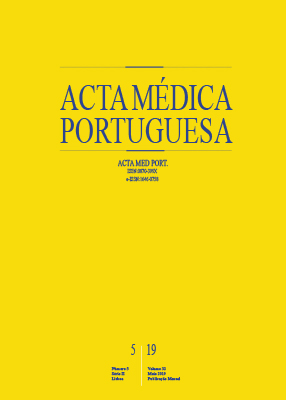Fournier’s Gangrene: 10-Year Experience of a Plastic Surgery and Burns Department at a Tertiary Hospital
DOI:
https://doi.org/10.20344/amp.11003Keywords:
Fournier Gangrene/surgery, Fasciitis, Necrotizing Plastic Surgery, Portugal, Reconstructive Surgical ProceduresAbstract
Introduction: Fournier gangrene is a polymicrobial life threatening infection of perineal subcutaneous soft tissues with its point of origin in urologic, colorectal or skin diseases. Although more frequent in elderly and men, it can affect all genders and age groups. Perianal abscess, diabetes mellitus and Escherichia coli are the most frequent cause, predisposing comorbidity, and microorganism found in tissue culture analysis respectively. The objective of this study was to describe the experience of a Plastic Surgery Department of a tertiary Hospital in reconstructing Fournier’s gangrene perineal defects and its detailed demography.
Material and Methods: The sample is composed of all patients with Fournier gangrene admitted in the Plastic Surgery and Burns Department. The authors retrospectively collected and analyzed demographic and clinical data during a period of 10 years including gender, age, length of stay, cause, number of debridements, predisposing factors, microbial culture results, surgical reconstructive techniques and its associated complications, additional surgical procedures and outcomes.
Results: Fifteen patients were identified: 14 males (93%) and one female (7%); mean age was 66.9 years (range: 46 - 86); mean, length of stay was 46.8 days (range: 20 - 71 days) and mean number of debridements was 3.3 (range: 1 - 4). The most frequent predisposing factor was diabetes mellitus, the major cause was perianal (n = 2) and skin abscess (n = 2). Eight (53.3%) patients had no identifiable source of Fournier gangrene. Various types of reconstructive techniques were employed; and 5 additional surgical interventions (33.3%) were undertaken (one cystostomy, two orchidectomy, two ileostomy); six patients (40%) presented reconstructive technique complications with adequate final outcome.
Discussion: In contrast with the literature, where Escherichia coli was the most frequently isolated agent, Staphylococcus aureus was the most frequent microorganism found in tissue biopsy/pus collection analysis. A higher than expected number of patients (n = 8) had no identifiable source of Fournier gangrene. This findings can be explained by the retrospective non-multicentre study limitation, with a potencial source of bias patients that were transferred from other hospitals in advanced stage, without point of origin of Fournier’s gangrene identified.
Conclusion: Early recognition and extensive necrotic tissue debridement, along with prompt and adequate antimicrobial treatment, are the mainstay of Fournier gangrene management, thus reducing morbidity and mortality in these patients. Surgical reconstruction challenges derived from this condition should be addressed by specialized teams due to the risk of dysfunctional sequelae and conspicuous deformities. Taking in account the single-center and retrospective observational character of the present study, these premises require proper validation from a multicenter prospective study.
Downloads
Downloads
Published
How to Cite
Issue
Section
License
All the articles published in the AMP are open access and comply with the requirements of funding agencies or academic institutions. The AMP is governed by the terms of the Creative Commons ‘Attribution – Non-Commercial Use - (CC-BY-NC)’ license, regarding the use by third parties.
It is the author’s responsibility to obtain approval for the reproduction of figures, tables, etc. from other publications.
Upon acceptance of an article for publication, the authors will be asked to complete the ICMJE “Copyright Liability and Copyright Sharing Statement “(http://www.actamedicaportuguesa.com/info/AMP-NormasPublicacao.pdf) and the “Declaration of Potential Conflicts of Interest” (http:// www.icmje.org/conflicts-of-interest). An e-mail will be sent to the corresponding author to acknowledge receipt of the manuscript.
After publication, the authors are authorised to make their articles available in repositories of their institutions of origin, as long as they always mention where they were published and according to the Creative Commons license.









